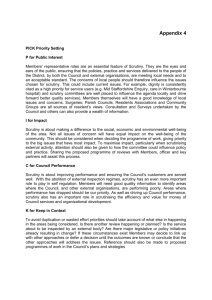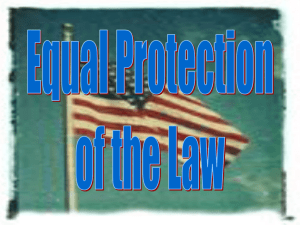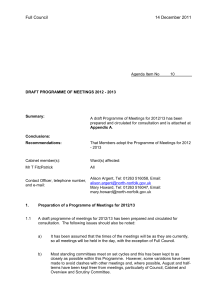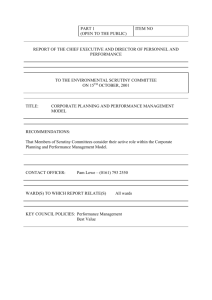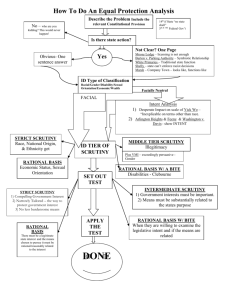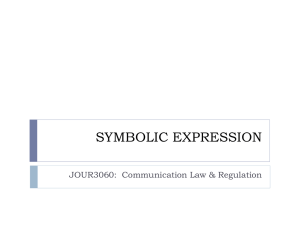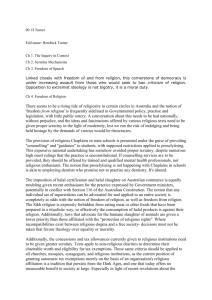Overview and Scrutiny Annual Report and Guidelines 2010 - 2011 Chairman’s Introduction
advertisement
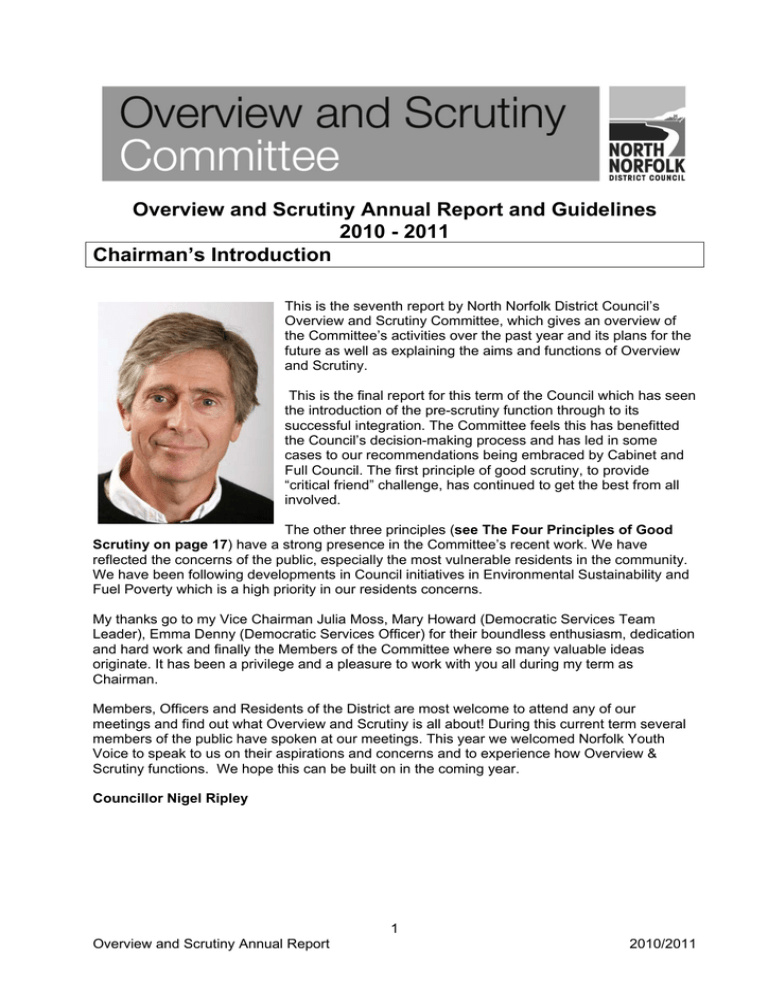
Overview and Scrutiny Annual Report and Guidelines 2010 - 2011 Chairman’s Introduction This is the seventh report by North Norfolk District Council’s Overview and Scrutiny Committee, which gives an overview of the Committee’s activities over the past year and its plans for the future as well as explaining the aims and functions of Overview and Scrutiny. This is the final report for this term of the Council which has seen the introduction of the pre-scrutiny function through to its successful integration. The Committee feels this has benefitted the Council’s decision-making process and has led in some cases to our recommendations being embraced by Cabinet and Full Council. The first principle of good scrutiny, to provide “critical friend” challenge, has continued to get the best from all involved. The other three principles (see The Four Principles of Good Scrutiny on page 17) have a strong presence in the Committee’s recent work. We have reflected the concerns of the public, especially the most vulnerable residents in the community. We have been following developments in Council initiatives in Environmental Sustainability and Fuel Poverty which is a high priority in our residents concerns. My thanks go to my Vice Chairman Julia Moss, Mary Howard (Democratic Services Team Leader), Emma Denny (Democratic Services Officer) for their boundless enthusiasm, dedication and hard work and finally the Members of the Committee where so many valuable ideas originate. It has been a privilege and a pleasure to work with you all during my term as Chairman. Members, Officers and Residents of the District are most welcome to attend any of our meetings and find out what Overview and Scrutiny is all about! During this current term several members of the public have spoken at our meetings. This year we welcomed Norfolk Youth Voice to speak to us on their aspirations and concerns and to experience how Overview & Scrutiny functions. We hope this can be built on in the coming year. Councillor Nigel Ripley 1 Overview and Scrutiny Annual Report 2010/2011 OVERVIEW AND SCRUTINY COMMITTEE REPORT 2010 - 2011 1. The Work of the Scrutiny Committee in the year 2010 - 2011 Membership of the Committee 2010 - 2011 Chairman: Nigel Ripley Vice Chairman: Julia Moss Sue Arnold Robin Combe Helen Eales (from October 2010) Brian Hannah Philip High Barbara McGoun John Perry-Warnes Anthea Sweeney Angie Fitch-Tillett (until October 2010) Joyce Trett Cath Wilkins In the year 2010 – 2011 the Overview and Scrutiny Committee Work Programme has covered the following: • Cyclical Reports and ongoing reviews Business Continuity (May, November 2010) Sustainability (June, December 2010) North Norfolk Safer Communities Partnership (June, December 2010, April 2011) Performance Management (June, October, December 2010, March 2011) Finance reports – including Budget Monitoring, Final Accounts and Budget 2010/2011 (June, September, November, December 2010, January, March, April 2011 and special meetings on 11 June 2010 and 18 February 2011) Customer Compliments, Complaints, Suggestions (September 2010, March 2011) Street Name Signs (April 2011) Development Control Committee Structure (March 2011) • Pre- scrutiny Waste and other contact procurement (update at every meeting until the contract was awarded in October 2010) Health Strategy (Bi-monthly since June 2010) Duty to respond to petitions (June 2010) Persistent Complainers Protocol (July 2010) North Norfolk Housing Strategy Discussion Document (September 2010) Youth Inclusion Strategy (December 2010) (to be reviewed every 6 months) • New Topics since 2009/2010 Weather Conditions in District Council Car Parks (May and June 2010 with an update in November 2010) 2 Overview and Scrutiny Annual Report 2010/2011 Health Strategy (bi-monthly from June 2010) Domestic Violence (June – December 2010) Fuel Poverty (March 2011) Business Support (March 2011) Duty to respond to petitions (June 2010) Persistent Complainers Protocol (July 2010) North Norfolk Housing Strategy Discussion Document (September 2010) Youth Inclusion Strategy (December 2010) (to be reviewed every 6 months) • Overview and Scrutiny Update Every agenda includes an Overview and Scrutiny Update. This report by the Democratic Services Team Leader informs Members of developments since the last meeting and provides any additional information that has been requested by Members. Some issues continue to be monitored until Members are satisfied that a good outcome has been achieved. The Update report also allows Members an opportunity to discuss any changes to the Work Programme and the scrutiny process in general. In November 2010 the Work Programme was reviewed in the light of new Government policy and changes in legislation but the Committee decided that all the topics were still relevant. 2. Summary of 2010 - 2011 The Overview and Scrutiny Committee has had another busy year with a heavy workload. There continues to be an increase in pre-scrutiny as its value in the decision-making process becomes increasingly recognised. A major waste and other contract procurement project has been the subject of a regular update from its inception in early 2009 until the contract was awarded in October 2010. It has not been necessary to employ the Councillor Call for Action mechanism at North Norfolk District Council since the legislation was introduced and it is hoped this is because any issues have been resolved through the Council’s standard procedures. The Duty to Respond to Petitions came into effect on 15 June 2010 as a result of the Local Democracy Economic Development and Construction Act 2009. The Council’s petitions scheme includes a provision for referring a petition to the Overview and Scrutiny Committee where the petition organiser is not satisfied by the actions taken by the authority. Petitions can be submitted in hard copy or online via a portal on the Council’s website. To date none have been received which is unsurprising as, historically, petitions have not been a preferred method of public engagement in the District. The Committee continues to examine Performance Management on a cyclical basis and looks in greater depth at areas of significant over or under performance. This is a valuable exercise. It is encouraging to see when things are going well. When things are not going so well it gives Members an opportunity to invite the relevant officers to the Committee and to discuss together how things can be improved. Regular finance reports are also received by the Committee, usually after they have 3 Overview and Scrutiny Annual Report 2010/2011 been to Cabinet and before they are presented to Full Council. This enables the Committee to make any recommendations before the report goes to Full Council. Significant reviews in 2010/11 have included: a) Weather Conditions in District Council Car Parks (May and June 2010 with an update in November 2010): this topic came to the Committee at the request of Cabinet and was a response to difficulties experienced in the District during the harsh winter of 2009/2010. The review included interviewing an external witness, the Project Manager for Planning and Transportation, Norfolk County Council. Members were informed of plans being put into place for dealing with the impact of adverse weather conditions on the Council’s car parks and access to the Christmas Seaside Special show on Cromer Pier. They requested an update in November 2010 to ensure that these plans were in place and were satisfied with the arrangements. b) Health Strategy: this topic was first introduced on to the Work Plan in June 2010. Bi-monthly updates continue to be received to enable Members of the Overview and Scrutiny Committee to make input into the Health Strategy. c) Domestic Violence (June – December 2010): this topic arose from a report from the North Norfolk Safer Communities Partnership in June 2010 when Members expressed concern at the statistics regarding Domestic Violence. In July they received a presentation on the subject by the Community Liaison Officer. This was followed by further work in September and October 2010. Throughout the investigation the main message was that awareness was the most important tool in tackling domestic violence and that this was an area where Members could use their influence. It was agreed to continue to monitor work being done to tackle Domestic Violence via cyclical reports on crime and disorder issues. An update is due to be received in July 2011. d) Fuel Poverty (March 2011): this report provided Members with an overview of fuel poverty in the District including its links to health issues. The Committee approved a pilot project to tackle fuel poverty and is due to receive an update in October 2011. e) Business Support (March 2011): Members asked for a presentation on Business Support as a result of the Performance Management Report received in February 2011. They were impressed by the outstanding performance in this field and wanted to know more about the work of the Economic and Tourism Development team. f) In December 2010 the Committee received a presentation on the Youth Inclusion Strategy 2011 – 2014 by members of the North Norfolk Youth Voice (NNYV). Prior to the presentation the Chairman of Overview and Scrutiny and a Member of the Committee had attended a meeting of NNYV. A six-monthly update will be received by the Committee. This is a valuable opportunity to help young people engage positively with the democratic process. 3. Links with other scrutiny bodies Representation on other bodies: • County Strategic Partnership Joint Scrutiny Panel (Nigel Ripley) • Norfolk Health Overview and Scrutiny Committee (Barbara McGoun) 4 Overview and Scrutiny Annual Report 2010/2011 • North Norfolk Community Partnership Scrutiny Board (Nigel Ripley) • North Norfolk Safer Communities Partnership (Brian Hannah) • Norfolk Scrutiny Network (Democratic Services Team Leader) 4. Towards the future Aims of the Overview and Scrutiny Committee for 2011/2012 include: • • • • Training new Members for the role of lay scrutineer after the election in May 2011. Making the public more aware of the role of Scrutiny and what it can do for them Taking Scrutiny out of the Council Chamber and into the community. Making more use of task groups to work on specific topics rather than overloading the work programme of the full committee. Challenges for the Overview and Scrutiny Committee 2011/2012: • • • • • New Committee composition – at the end of the year 2010/11 two very experienced Members of the Overview and Scrutiny Committee, including the Chairman, retired. Changes in the way that performance is reported Provision of services despite spending cuts Responding to the Policing and Social Responsibility Bill Responding to the Localism Bill 5. Work Programme 2011 – 2012 The Work Programme for 2011 – 2012 will be set as soon as possible in the new municipal year and be reported to Full Council. 6. Officer Support The Overview and Scrutiny Committee is supported by the Democratic Services Team Leader, Mary Howard, and Democratic Services Officer Emma Denny. 5 Overview and Scrutiny Annual Report 2010/2011 GUIDELINES 1. Introduction The purpose of these guidelines is to provide information and guidance on North Norfolk District Council’s Overview and Scrutiny Arrangements. The guidelines contain practical help for anyone involved in the Scrutiny Process. This includes not only the Members of the Overview and Scrutiny Committee, but the Cabinet and Members of other committees. It also includes officers who are involved in the development of policy or who might be called upon to make a report to the Overview and Scrutiny Committee, as well as members of the public, partners and external service providers who may be invited to give evidence. Scrutiny helps to ensure that the Council’s objectives are delivered by enabling an open and transparent environment for Members to shape, question, evaluate and challenge its policies, decisions and performance. The role of the Overview and Scrutiny Committee is distinct from that of the Cabinet (Executive), but does not serve as an opposition, being essentially apolitical. The best way to think of the Committee is as a “critical friend”. The Overview and Scrutiny Committee can also play a role in developing and proposing new policies for the Council and sometimes other organisations, especially where the Council is a Stakeholder. There is also a role in helping to monitor and improve existing policies and practices. The Overview and Scrutiny Committee is not a decision making body but can seek to influence and enhance decisions made by the Cabinet and the Council in the best interests of the local community and without party politics playing a part. 2. What is Scrutiny? The Overview and Scrutiny Committee is the Council’s watchdog, ensuring that the Cabinet is held to account and is carrying out the Council’s aims as well as getting the best value for money as a result of its decisions. Originating from the Local Government Act of 2000 Scrutiny Committees not only keep an eye on the Council but can also review the work of other bodies such as the Police, our utility providers and the voluntary sector. The remit of the Overview and Scrutiny Committee also includes undertaking policy review and development, monitoring performance management, promoting community well-being and improving the quality of life in the District. Scrutiny is Member-led and independent of political party arrangements. At North Norfolk District Council the Overview and Scrutiny Committee is chaired by a member of the opposition. Scrutiny is a function which belongs to, and benefits the whole council. Good officer support is essential to the Overview and Scrutiny Committee for advice, information and research. 6 Overview and Scrutiny Annual Report 2010/2011 3. Local Government Act 2000 and the Council’s Constitution The Local Government Act 2000 required councils to adopt different ways of working to the traditional service-based Committee arrangements that most councils had been operating since 1974. In particular, councils were required to adopt new political arrangements, and North Norfolk District Council’s political structure is based on the Leader and Cabinet model. The Cabinet is the main decision making body of the Council (with the exception of regulatory committees such as the Development Control Committee) and is responsible for developing the Council’s policy and budget framework, and implementing these once they have been agreed by Full Council. Overview and Scrutiny is a fundamental part of these arrangements. It enables the Council to ensure that its policies are robust and effective, that the Cabinet makes decisions in accordance with Council policy and that the Council delivers services that the public wants and needs. Being involved in Overview and Scrutiny helps members to represent their community effectively. The Terms of Reference of the Overview and Scrutiny Committee are as follows: 1. To scrutinise and review decisions or other actions taken with respect to Cabinet functions. This includes call-in of Cabinet decisions. 2. To scrutinise and review decisions or other actions taken with respect to non-executive functions. 3. To make reports or recommendations to the Full Council or to the Cabinet about one or more particular issue(s), service(s) or matter(s), which affect North Norfolk and its residents. Reports or recommendations may be carried out on whatever issue, service or matter the Scrutiny Committee thinks fit and may be carried out on any subject if the Full Council or the Cabinet requests it to do so. 4. To carry out best value reviews. 5. To act as the Council’s Crime and Disorder Committee. 6. To produce an annual report to Council on the work of the Committee over the year. 4. The Councillor Call for Action On 21 October 2009 the Overview and Scrutiny Committee resolved to adopt a protocol for the Councillor Call for Action and that the Council’s Constitution should be updated accordingly. The process is set out below. A Councillor Call for Action request form can be found at page 21 of this booklet. 7 Overview and Scrutiny Annual Report 2010/2011 1. Introduction 1.1 The “Councillor Call for Action” (CCfA) was introduced under Section 119 of the Local Government and Public Involvement in Health Act 2007. 1.2 The 2007 Act enables any member of the Council to refer to the Overview and Scrutiny Committee any local government matter which affects their Ward and is relevant to the functions of the Committee. 1.3 In addition, Section 119 of the Police and Justice Act 2006 came into force on 30 April 2009 and enables any member of the Council to refer to the crime and disorder committee any local crime and disorder matter which affects their Ward. The Overview and Scrutiny Committee will discharge the function of the crime and disorder committee. 1.4 The power to refer a matter is available only where the matter is of direct concern to the ward or division which the councillor represents. The matter may affect all or part of the ward member’s area or any person who lives or works in that area. A councillor can refer a matter even if no citizen has asked him/her to consider it, and there is no requirement for councillors in multi-member wards to agree – any of them can refer a matter. 2. Limitations 2.1 It is important to recognise that CCfA is not guaranteed to solve a given problem. CCfA can provide a method for discussing such problems and, through discussion, trying to overcome them. 3. Issues excluded from referral as a CCfA 3.1 The Overview and Scrutiny (Reference by Councillors) (Excluded Matters) (England) Order 2008 excludes the following matters from referral as a CCfA: 3.1.1 Any matter relating to an individual or entity where there is already a statutory right to a review or appeal (other than the right to complain to the Local Government Ombudsman), for example: Council Tax/Housing Benefit appeals or Issues currently under dispute in a court of law. 3.1.2 Any matter relating to a planning or listed building application or enforcement decision. Any matter relating to a licensing application, review or enforcement decision. 3.1.4 Any matter which is vexatious, discriminatory or not reasonable to be included on the agenda for, or to be discussed at, a meeting 8 Overview and Scrutiny Annual Report 2010/2011 of the Overview and Scrutiny Committee or any of its subcommittees. 3.2 A matter will not be excluded under 3.1.1 to 3.1.3 where the allegation consists of the function not being discharged at all or that the function has failed or is failing on a systematic basis. 3.3 A referral, provided it is covered by the legislation and is not an excluded matter (see above), will ensure that the matter is included on the agenda of the Overview and Scrutiny Committee. It is then up to the members of the Committee to decide whether or not to take the matter further. 3.4 A referral made to the Overview and Scrutiny Committee is seen as being the end of the CCfA process (the last resort) and not the first step. 4. Steps to be taken prior to making a Councillor Call for Action referral. 4.1 Prior to a councillor referring a matter as a CCfA to the Overview and Scrutiny Committee, a councillor must have tried to resolve the issue/problem themselves using all mechanisms and resources available to them at ward level. Councillors should: If a local crime and disorder matter, raise the issue through the Community Safety Partnership to find a way to resolve the issue. Ensure that all relevant partner organisations have been informed of the issue and given enough time to resolve it, for example through formal letter written on behalf of constituents, discussion at public meetings, petitions, communication with local MPs and councillors in other authorities etc. Ensure that all relevant internal potential routes to solution have been followed, for example informal discussions with officers and/or members, questions at committees, motions on the agenda at full Council etc. Ensure that this is not an issue that is currently being or should be pursued via the Council’s complaints procedure. Ascertain whether or not any other form of local scrutiny is investigating the issue, eg Norfolk County Council. 5. How to make a Councillor Call for Action referral 5.1 If the issue/problem is still not resolved the councillor can refer it to the Overview and Scrutiny Committee as a “Councillor Call for Action”. To do this the councillor should complete and submit to the Strategic Director (Information) a CCfA Request Form outlining what the issue is and what steps have been taken towards a resolution. The request form, a specimen is attached as Appendix 1, is available on the Council’s website, or from the Strategic Director (Information). The request form for a CCfA includes: - The name of the councillor and ward they represent. - Title of the CCfA and date of submission. 9 Overview and Scrutiny Annual Report 2010/2011 - Why you think the issue should be looked at by the Overview and Scrutiny Committee. A brief synopsis of what the main areas of concern are. What evidence you have in support of your CCfA. Which areas or community groups are affected by the CCfA. What you have done to try and resolve the issue prior to requesting a CCfA. Whether the CCfA is currently the subject of legal action by any party (to your knowledge) or is being examined by a formal complaints process. Whether there are any deadlines associated with the CCfA of which the Overview and Scrutiny Committee needs to be aware. 5.2 The Strategic Director (Information) will receive the referral form, log it to track its progress, and, after consultation with the Monitoring Officer, assess the issue to ensure that it is covered by the legislation referred to above and is not a matter excluded from referral to the Overview and Scrutiny Committee. 5.3 A decision that a matter is excluded pursuant to paragraph 5.2 above will only be taken by the Strategic Director (Information) after consultation and agreement with the Chairman and Vice-Chairman of the Overview and Scrutiny Committee. 5.4 The Strategic Director (Information) will inform the Chairman of the Overview and Scrutiny Committee that the item will be included on the next Committee agenda. The Councillor will be informed whether or not their referral has been successful. 5.5 A successful referral will ensure that the CCfA will be placed on the next agenda of the Overview and Scrutiny Committee. It is then up to the members of the Committee to decide whether or not to take the matter further. 6. Decision of the Committee whether to take the matter further 6.1 6.2 In deciding whether or not to take the matter further the relevant Overview and Scrutiny Committee will consider: - Anything that the councillor has done in relation to this matter; and - Representations made by the councillor as to why the Committee should take the matter up. (Councillors have the option of either presenting their CCfA form without supporting papers, or of preparing a report setting out their views). The criteria the Committee will use to decide whether or not to take the matter further include: Is the Committee satisfied that all reasonable attempts have been made to resolve the issue by the ward councillor? And 10 Overview and Scrutiny Annual Report 2010/2011 - - do the responses received by the referring councillor demonstrate that the matter is not being progressed? Has the Committee considered a similar issue recently – if yes have the circumstances or evidence changed? Is there a similar or related issue which is the subject of a review on the current work plan? It may be more appropriate to link the new issue to an existing review, rather than hold a separate CCfA hearing. Relevant time pressures on resolving the CCfA should be taken into account. Have all relevant service areas or partner organisations been informed and been given enough time to resolve the issue? What response has the councillor received? Is this a case that is being or should be pursued via the Council’s complaints procedure? Is it relating to a “quasi-judicial” matter or decision such as planning or licensing? Is the issue part of an individual’s own personal agenda (an issue of genuine local concern should have an impact on the local community). Is this an issue currently being looked at by another form of local scrutiny, e.g. Norfolk County Council? And, as with all scrutiny, does the matter referred have the potential for scrutiny to produce recommendations which could realistically be implemented and lead to improvements for anyone living or working in the referring member’s ward? 6.3 In considering the CCfA, the Overview and Scrutiny Committee may invite the Chief Executive, Deputy Chief Executive or relevant Director, Manager or external organisation to discuss the issue with the Committee and answer any questions. 6.4 If the Committee decides not to accept the CCfA referral it must inform the Councillor and provide reasons. 6.5 If the Committee decides to accept the CCfA referral, it must decide how it intends to take the matter forward and include the CCfA in its work plan. This could include: Before holding a formal hearing: - Asking the service area(s)/partner organisation(s) to respond to the CCfA. - Setting up a research group to undertake a more in-depth review. At formal hearings: - Asking for further evidence and/or witnesses to be brought to a future meeting then making recommendations to the Cabinet/partner organisation. 11 Overview and Scrutiny Annual Report 2010/2011 7. Potential outcomes 7.1 Following a formal hearing, there are a number of potential outcomes from the Committee meeting: - - 7.2 The Committee could determine not to make a report or recommendations (perhaps because it is not considered the right time to consider a particular issue), with the ward Councillor notified in writing; The Committee could determine that it is a complex issue that requires further investigation and commission a scrutiny review of the issue; The Committee could write a report and make recommendations on the CCfA to the Cabinet and/or relevant partners. The Committee could make a report or recommendations to Full Council where the CCfA is a local crime and disorder matter. Once the Committee has completed its work on the CCfA referral the member who made the CCfA referral will receive a copy of any report or recommendations made. The report will also be made available on the Council’s website, unless the matter was an exempt item, in which case the report cannot be made public. 8. Timescales 8.1 Once the CCfA has been assessed as not being a matter which is excluded from referral to Overview and Scrutiny Committee, the item will be included on the next Committee agenda. 8.2 If the Committee agrees to take the matter forward, the hearing will usually be held as an item on the next available agenda. In exceptional circumstances, for example where there are unavoidable time constraints, a separate meeting may be convened. 8.3 Should a CCfA hearing result in recommendations to Cabinet or Full Council being made, an item will be placed on the agenda for the next Cabinet or Full Council, respectively. 8.4 Should a CCfA hearing result in recommendations to partner organisations, such organisations will also be requested to make a response to the recommendations, although they are under no legal obligation to do so. 12 Overview and Scrutiny Annual Report 2010/2011 Summary of CCfA Mechanism Ward Councillor identifies issue of local concern. Ward Councillor rejects request in line with best practice and guidance. Signposting/advice about other mechanisms. Ward Councillor agrees to champion the request. Ward Councillor and local partners resolve issue - no further action required. Ward Councillor and relevant officers, members and relevant local partners try to resolve the issue informally. Ward Councillor agrees to refer difficult problems that cannot be resolved as a formal CCfA. Request logged with Strategic Director (Information). The Strategic Director (Information) informs the Chairman of the relevant Overview and Scrutiny Committee that a CCfA request form has been received, and after consultation with the Legal Services Manager ensures it is not an exempt item, and includes it on the next Committee agenda. The Overview and Scrutiny Committee agrees to review and includes the CCfA on its work programme. The Overview and Scrutiny Committee decides not to review the issues and give its reasons. Following investigation, draft report agreed informally by the Overview and Scrutiny Committee, and issued for response to the recommendations. Cabinet to consider recommendations. Relevant partners requested to respond to recommendations as appropriate. Implementation/monitoring of agreed recommendations and appropriate feedback on progress. Scrutiny Handbook and Annual Report 13 2010/2011 Explanatory Notes Definition of a local government matter and a local crime and disorder matter Local government matter For the purpose of the 2007 Act a “local government matter”, in relation to a member of a local authority is one which: - Relates to any discharge of any function of the authority; - Affects all or part of the electoral area for which the referring member is elected or any person who lives or works in the area (ie it must be specific to a particular locality); and - Is not an excluded matter. However, the guidance produced by the Centre for the Public Scrutiny and Improvement and Development Agency advises that, to give full effect to CCfA, the interpretation of “local government matter” needs to be broader. This includes issues relating to the Council’s partners, in line with the area focus of Comprehensive Area Assessment (CAA), and the fact that an authority’s duties increasingly impact on other organisations, and involve partners within and outside the Local Strategic Partnership (LSP). Local crime and disorder matter A “local crime and disorder matter”, in relation to a member of a local authority, has been defined in the 2006 Act to mean a matter concerning: crime and disorder (including in particular forms of crime and disorder that involve anti-social behaviour adversely affecting the local environment); or the misuse of drugs, alcohol and other substances that affects the electoral area represented by the member, or the people who live or work in that area. Definitions of “vexatious”, “persistent”, “discriminatory” and “not reasonable” Statutory regulations deal with matters that can be excluded from CCfA, stating that “any matter which is vexatious, discriminatory or not reasonable to be included on the agenda for, or to be discussed at, a meeting of the Overview and Scrutiny Committee is to be excluded”. Vexatious/Persistent Deciding whether a request is vexatious is a balancing exercise, taking into account all the circumstances of the case. There is no rigid test or definition, and it will often be easy to recognise. The key question is whether the request is likely to cause distress, disruption or irritation, without any proper or justified cause. Issues around persistency are implied by this definition. However, a persistent request may well be entirely valid – it may relate to a systematic problem that has not been effectively resolved. CCfAs need to be looked at on their merits, Scrutiny Handbook and Annual Report 14 2010/2011 rather than on the basis of who is bringing them, or whether somebody thinks there is an ulterior motive for them being brought. Where a request for a CCfA is clearly vexatious, detailed reasons for coming to this decision will be given to the councillor concerned. There could, however, be instances where changes to the scope of the CCfA, or its focus, could make it more acceptable while still meeting the councillor’s requirements. Discriminatory A modern interpretation of the word “discrimination” is provided at Section 45 of the Equality Act 2006, in relation to religion and belief, as follows: A person (A) discriminates against another (B) if on the grounds of the religion or belief of B or of any other person except A, A treats B less favourably than he treats others. This definition can easily be amended to deal with other forms of discrimination, such as discrimination for reasons of sex and/or race. So a discriminatory CCfA might be one which implies or states that a group of people or an area should receive better, or worse, services on account of that group’s predominant religion, race, gender or other characteristic, as covered by discrimination legislation. Not reasonable It is suggested that, in the interests of transparency, authorities do not interpret “not reasonable” as being the same as the legal word “unreasonable”. It is best to consider it as a qualifier to the word “vexatious”, as a vexatious request is likely not to be reasonable and a request that is not reasonable is likely to be vexatious. Structure of the CCfA hearing The protocol is intended to formalise the conduct of CCfA hearings and the preparation work carried out in the run-up to such a hearing. It should be noted, however, that the protocol may be varied by the Chairman of the Overview and Scrutiny Committee to meet the requirements of any particular circumstances. Prior to the hearing The CCfA Request Form and any additional papers provided by the referring councillor will be published with the agenda for the meeting. The referring councillor and relevant officers and partners will be invited to the meeting. Any other relevant external witnesses will be invited to the meeting. Seven days’ notice of a request to attend the meeting will be given to all participants. If a question plan is to be produced, seven days’ notice of the questions planned will also be given to participants. Scrutiny Handbook and Annual Report 15 2010/2011 Prior to the meeting any member who may have a conflict of interest will be given relevant advice by the Monitoring Officer. The hearing The CCfA hearing will normally be the first item of business on the agenda, in order that participants and other witnesses are not kept waiting. The referring councillor will be invited to make a presentation outlining his or her main reasons for referring the matter as a CCfA. A question and answer session will follow. Any other parties relevant to the hearing, for example Member Champions, officers or partners, will be invited to make presentations outlining their response to the CCfA. Question and answer sessions will follow. Any other relevant external witnesses will be invited to make a presentation to the Committee without interruption, following which there will be a question and answer session. Witnesses will be given the opportunity to add any points of clarification before any resolution or recommendation is moved. The referring councillor will be given the opportunity to add any points of clarification before any resolution or recommendation is moved. Scrutiny Handbook and Annual Report 16 2010/2011 5. The four principles of good scrutiny The Centre for Public Scrutiny has identified four Principles of Good Scrutiny. These apply to all Councils, regardless of their size or the scale of their Scrutiny operation. • Providing ‘critical friend’ challenge to Executives as well as external authorities. • Reflecting the voice and concerns of the public and its communities. • Taking the lead and owning the scrutiny process on behalf of the public. • Making an impact on the delivery of public services. Effective Overview and Scrutiny depends on a high level of awareness and understanding of its role. Member leadership and engagement and a responsive Executive are also essential, as well as genuine consensual working, dedicated officer support and a supportive Senior Officer culture. 6. The Aims of the Overview and Scrutiny Committee The Aims of the Overview and Scrutiny Committee include: a) b) c) d) e) f) g) To work independently of political arrangements in a constructive atmosphere built on mutual respect and trust. To be Member-led, that is Members taking the lead in choosing topics and in questioning witnesses; Cabinet Members answering questions regarding topics within their portfolios. To be open and transparent in all their business. To achieve consensus To work creatively, considering which methods or locations best suit a specific review. To ensure the best outcomes for the Council and for the Public. To keep informed of the latest developments in Scrutiny which is a constantly evolving process. 6. Scrutiny Activities Scrutiny activities include: a) b) c) Questioning the Cabinet, Members of other Committees and Officers. This could be as a result of a call-in; or a concern regarding the performance in a particular service; or a review of progress as follow-up to a previous investigation. When scrutiny of a service takes place, the relevant Portfolio Holder, as well as officer, is invited. Commenting on Budget Proposals – Budget Monitoring and Draft Budget reports are cyclical items on the Scrutiny Committee Work Programme. Commenting on Corporate Priorities – the Scrutiny Committee is scheduled to enable Members to examine, discuss and make comment on Corporate Priorities and to make recommendation to Full Council if relevant. Scrutiny Handbook and Annual Report 17 2010/2011 d) e) f) g) h) i) j) k) Contributing to the Development of Draft Policies – in the cycle of meetings, draft policies are seen by Cabinet and Scrutiny, before going to Full Council. Pre – Scrutiny: this enables greater co-ordination between the Cabinet and Scrutiny work programmes and facilitates Overview and Scrutiny Committee input into key agenda items, thus reducing the likelihood of call – ins (see below) Scrutiny of Decisions made by Cabinet – Call-ins. The Overview and Scrutiny Committee can “call in” a decision which has been made by the Cabinet but not yet implemented. This enables it to consider if the decision is appropriate and it may recommend that the Cabinet reconsider the decision. Performance Monitoring – this is a regular cyclical item on the work programme. Performance Monitoring reports are a useful tool in highlighting areas which may require further investigation. They are equally important for showing areas of the Council’s work which are going particularly well! Scrutiny Topic Investigations and Research – the Overview and Scrutiny Committee may choose to look at a topic in depth and over a period of time. Research is conducted by the Scrutiny support officer and Members themselves: the research might include finding out if other councils have already done work on the topic, and what lessons could be learned from it; guidance from the Centre for Public Scrutiny, Government publications and other bodies. Responding to new Legislation and Consultations – e.g. the new Local Government and Public Involvement in Health Act. Scrutinising other Public Bodies and the Voluntary Sector – e.g. the Police, utilities providers, particularly where there are areas of local concern. Links with other scrutiny bodies 7. The Scrutiny process a) Before the Agenda is prepared a pre-Agenda meeting takes place between the Chair, Vice Chair, Scrutiny support and other relevant officers. This is an opportunity to discuss the Committee’s requirements and to ensure that they are covered in any reports. After the Agenda has been sent out, Members of the Committee are encouraged to notify questions in advance, giving reporting officers time to prepare comprehensive responses. All non-executive Members are invited, via the Members’ Bulletin, to submit questions b) Overview and Scrutiny Committee meetings take place usually on Wednesdays, two weeks after Cabinet to allow time for call – ins. Each meeting of Scrutiny includes “Scrutiny Update” an opportunity to follow-up on the progress of reviews and recommendations. The Committee links its work to the aims of “Changing Gear”, the Council’s corporate plan, using a matrix that checks the relevance and value of every topic suggested for scrutiny. The Committee also has powers to investigate issues concerning outside organisations such as the police and utilities providers, especially where there are areas of public concern. As well as topics chosen by the Committee for their Work Programme, cyclical reports on Budget Monitoring and Performance Management come to Scrutiny. The Overview and Scrutiny Committee, although not a decision making body can, and frequently does, make recommendations to Full Council. c) As well as the full Committee, working groups may be formed to undertake longer term reviews of specific subjects. Membership of working groups tends to comprise those who have a particular interest or expertise in the area under Scrutiny Handbook and Annual Report 18 2010/2011 investigation, with participation by relevant lead officers. The working groups report to the main Committee. d) Overview and Scrutiny is a relatively new and, consequently, evolving process. It is essential that Members and Officers keep up to date with new developments and for this reason are encouraged to attend training and seminars both internally and externally. North Norfolk District Council is a member of the Norfolk Scrutiny Network which is a valuable forum for the exchange of ideas. Members are also circulated with publications from the Centre for Public Scrutiny (CfPS) as and when appropriate. CfPS also have an excellent website. e) Call – ins (see 6(f)). It is vital that Scrutiny members are aware of what is on the agenda of the Cabinet, especially in those areas that are of public concern. The Chair and Vice Chair of Scrutiny regularly attend meetings of the Cabinet. 8. Who Gets Involved in Scrutiny and their Roles? a) The Chairman and Vice Chairman of the Overview and Scrutiny Committee take a pro-active role throughout the Scrutiny process, attending pre-Agenda meetings and steering and scoping the direction of questioning and investigation. They attend, when appropriate, meetings with relevant officers at other authorities or with other bodies, and participate in internal and external training. b) The Overview and Scrutiny Committee Members – Scrutiny is different from other committees and calls for Members with investigative and creative minds who are prepared to “do their homework” out of the Council Chamber and to think outside of the usual committee framework, tailoring the method of review to suit the topic. c) Cabinet Portfolio Members are always invited to attend meetings of Overview and Scrutiny which involve their portfolio. The aim is that the Portfolio Member, as well as the officers, should respond to questions and, where appropriate, make presentations. d) All non-Executive Members are invited, via the Members’ Bulletin, to submit questions in advance of the Overview and Scrutiny Committee meeting, or to suggest topics for scrutiny. In most cases the topics being scrutinised are of interest to all Members and relevant to all wards. “Scrutiny Notebook” - an informal monthly report in the Members’ Bulletin has, for the last five years, been keeping councillors up to date with the Overview and Scrutiny Committee’s activities. e) Officers are involved in a number of ways – those directly involved in supporting the Scrutiny process and those who are called to make reports to the Committee. The Corporate Management Team is a key link in the process, providing essential information as well as advice. f) Invitees and Witnesses – invitees and witnesses can be called not just from within the Council, but from partners and utilities providers. The aim is to make invitees and witnesses feel at ease and they are asked to complete an appraisal form afterwards, so that the experience of scrutiny can be monitored and made more “user friendly” if necessary. g) The public are always welcome to attend meetings of the Overview and Scrutiny Committee and to suggest areas of public concern that they would like to see tackled by the Committee. A pro forma to request scrutiny of a topic can be found on page 20. Scrutiny Handbook and Annual Report 19 2010/2011 If you would like this document in large print, audio, Braille, alternative format or in a different language please contact mary.howard@northnorfolk.gov.uk Request form to raise an item for Scrutiny Review Councillors should be asked to carry out the following scrutiny review: Please give your reasons (continue on a separate sheet if necessary) Name: Address: Daytime Tel No Email: Signature Date Please return this form to Mary Howard, Democratic Services Team Leader, Council Offices, Holt Road, Cromer, NR27 9JW Tel 01263 516047 Email: mary.howard@north-norfolk.gov.uk Scrutiny Handbook and Annual Report 20 2010/2011 Councillor Call for Action Request Form This form should be used by any Councillor who would like the Overview and Scrutiny Committee to consider a Councillor Call for Action in their ward. Councillor The ward you represent: Title of your Councillor Call for Action: Date of Submission: Have you approached the Overview and Scrutiny Committee on the same issue in the past six months? Yes No Why you think the issue should be looked at by the Overview and Scrutiny Committee: Please give a brief synopsis of the main areas of concern: What evidence do you have in support of your CCfA: Which areas or community groups are affected by the CCfA: How have you tried to resolve the issue: Is the CCfA currently the subject of legal action by any party (to your knowledge) or being examined by a formal complaints process? Are there any deadlines associated with the CCfA of which the Overview and Scrutiny Committee needs to be aware: Please complete and return the form to: Tony Ing, Strategic Director – Information, Council Offices, Holt Road, Cromer, NR27 9JW Tel 01263 516080 Email: tony.ing@north-norfolk.gov.uk Scrutiny Handbook and Annual Report 21 2010/2011

